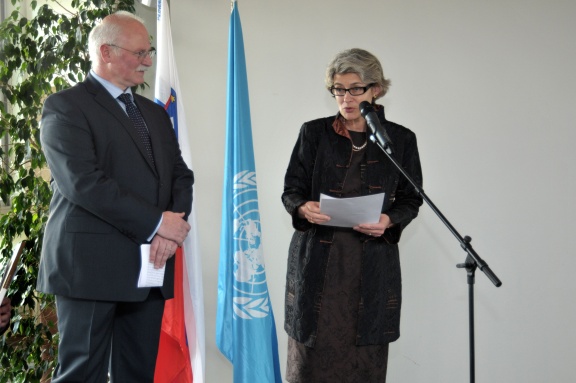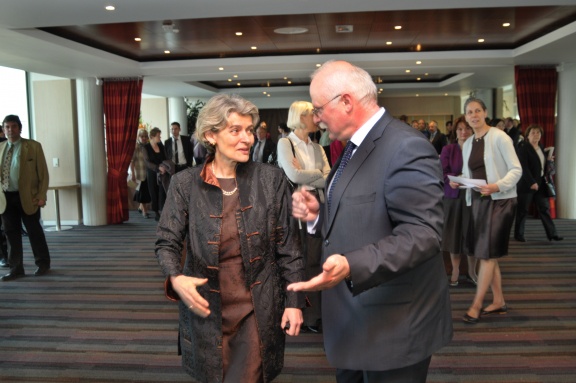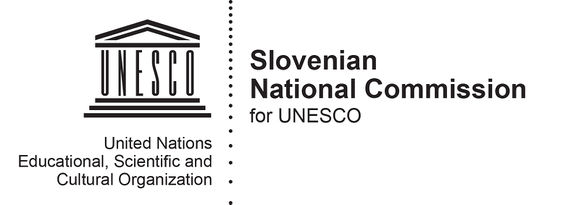Difference between revisions of "Slovenia National Commission for UNESCO"
Anže Zorman (talk | contribs) |
|||
| Line 43: | Line 43: | ||
The commission is also active in the field of [[UNESCO World Heritage Sites in Slovenia|heritage programmes]]. The [[Škocjan Caves World Heritage Site|Škocjan Caves]], one of the most famous sites in the world for the study of karst (limestone) phenomena, was inscribed on the UNESCO World Heritage List in 1986. In 2010 the two remains of prehistoric pile dwellings from the Ljubljansko Barje marshlands were selected to become part of the transnational heritage site "Prehistoric Pile Dwellings around the Alps". The latest addition is the [[Idrija Mine Museum#UNESCO World Heritage List|Heritage of Mercury. Almadén and Idrija]], listed in 2012. | The commission is also active in the field of [[UNESCO World Heritage Sites in Slovenia|heritage programmes]]. The [[Škocjan Caves World Heritage Site|Škocjan Caves]], one of the most famous sites in the world for the study of karst (limestone) phenomena, was inscribed on the UNESCO World Heritage List in 1986. In 2010 the two remains of prehistoric pile dwellings from the Ljubljansko Barje marshlands were selected to become part of the transnational heritage site "Prehistoric Pile Dwellings around the Alps". The latest addition is the [[Idrija Mine Museum#UNESCO World Heritage List|Heritage of Mercury. Almadén and Idrija]], listed in 2012. | ||
| − | UNESCO’s Tentative List, which is a required stage of the nomination process, currently has six Slovenian entries | + | UNESCO’s Tentative List, which is a required stage of the nomination process, currently has six Slovenian entries – Classical Karst since 1994 and 2015, the Fužina Hills in Bohinj since 1994, the [[Franja Partisan Hospital]] since 2000 (European Heritage Label 2015), the beech forests since 2015 and the architecture of [[Jože Plečnik]] in Ljubljana and Prague since 2015. The ''Walk of Peace from the Alps to the Adriatic – Heritage of the First World War'', a 230 kilometres long trail along the former WWI Isonzo front, was also put on the list in February 2016. |
==Communication and Information programmes== | ==Communication and Information programmes== | ||
Revision as of 09:31, 3 March 2016
Educational programmes
The Slovenia National Commission for UNESCO has been actively participating in UNESCO's educational programmes which have a broader, more basic and global scope providing for lifelong learning and 'education for all'. The Associated Schools Project Network (ASP) is active within the framework of the commission and includes 29 institutions, among them 18 elementary schools and nine secondary schools. The schools take part in international projects and every year a one-week international meeting is held in Piran. A brochure has been published by UNESCO and sent to all the countries.
World Heritage programmes
The commission is also active in the field of heritage programmes. The Škocjan Caves, one of the most famous sites in the world for the study of karst (limestone) phenomena, was inscribed on the UNESCO World Heritage List in 1986. In 2010 the two remains of prehistoric pile dwellings from the Ljubljansko Barje marshlands were selected to become part of the transnational heritage site "Prehistoric Pile Dwellings around the Alps". The latest addition is the Heritage of Mercury. Almadén and Idrija, listed in 2012.
UNESCO’s Tentative List, which is a required stage of the nomination process, currently has six Slovenian entries – Classical Karst since 1994 and 2015, the Fužina Hills in Bohinj since 1994, the Franja Partisan Hospital since 2000 (European Heritage Label 2015), the beech forests since 2015 and the architecture of Jože Plečnik in Ljubljana and Prague since 2015. The Walk of Peace from the Alps to the Adriatic – Heritage of the First World War, a 230 kilometres long trail along the former WWI Isonzo front, was also put on the list in February 2016.
Communication and Information programmes
In November 2011 the Institute of Information Sciences (IZUM) was granted a status of the Regional Centre for Library Information Systems and Current Research Information Systems (IZUM) as a UNESCO Category 2 centre. In September 2012 the agreement was signed in Paris.
Funding
In 2010 Municipality of Ljubljana took over the prestigious World Book Capital UNESCO title.
Alongside the celebrations in 2008 of the 500th anniversary of the birth of Primož Trubar, the founder of the literary Slovenian language and leader of the Protestant Reformation movement in Slovenia, the National Commission included his birthday on the world's anniversaries list.
UNESCO also supported the Crossradio multicultural radio station network (2001–2009), which included Radio Študent (RŠ) and Mariborski radio Študent (MARŠ) from Slovenia along with independent radio stations from Banja Luka, Belgrade, Mostar, Novi Sad, Sarajevo, Sombor, Skopje, Zrenjanin, Zurich, and Basel. Each week one of these stations contributed a half-hour programme which was broadcast by all members of the network. The aim of the project was to help reduce distrust and tension between the different cultures in South-east Europe, to encourage cultural dialogue and to promote the plurality of media while supporting freedom of expression.
See also
- UNESCO World Heritage Sites in Slovenia
- Škocjan Caves World Heritage Site
- Franja Partisan Hospital
- Idrija Municipal Museum
- Triglav National Park
- Ministry of Education, Science and Sport
External links
- UNESCO Slovenia website (in Slovenian)
- UNESCO World Heritage Centre website
- Slovene sites on the UNESCO World Heritage Tentative List
- About the UNESCO sites on Slovenia.si
- Crossradio tribute website and net radio (in Croatian)






